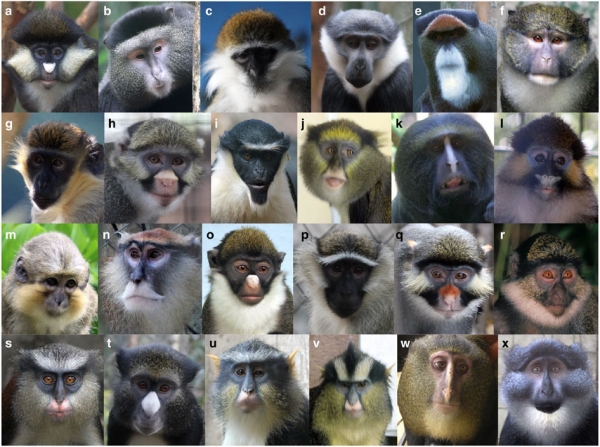A few days ago an interesting paper entitled "Character displacement of Cercopithecini primate visual signals" was published in Nature Communications by Allen, Stevens and Higham (click HERE to see a summary of their paper, and HERE, HERE and HERE to read some of the many news reports about the study). Cercopithecines are popularly known as guenon monkeys, and there certainly is a huge amount of physical diversity in the group.

Figure 1 from the study showing examples of guenon faces, illustrating interspecific diversity. Copyright: Nature, London
The authors introduce their study as follows: "Individuals from closely related species are often at risk of mating with each other and producing hybrids with reduced fitness. In addition to the reproductive disadvantages of interspecific [i.e. between different species] matings, there may also be ecological advantages that favour mixing with individuals of the same species in tasks such as foraging. Theory predicts that costly mismatings and associations with heterospecifics [different species] can be avoided by the evolution of species recognition signals that reliably identify individuals of the same species. To improve discrimination between groups, species recognition signals are expected to undergo character displacement whereby phenotypic differences between two or more populations become accentuated where their ranges overlap. [i.e. species whose geographical distributions overlap are expected to evolve to look different]" They conclude by saying "In summary, we have shown that in a large tribe of primates, face patterns have evolved to be especially distinctive from those that they share more of their range with. The likely cause of this relationship is that face patterns function as species recognition signals to promote and maintain reproductive isolation between species through either ecological or reproductive character displacement. The observed pattern is likely the result of the process of reinforcement [my emphasis], a key mechanism that can create new species."
So what has all of this got to do with Alfred Russel Wallace you might ask? Well, Wallace not only devised the theory of reinforcement - often called "the Wallace Effect" - but he also came up with the concept of "recognition marks" in 1877 as a mechanism by which reinforcement might operate. Sadly the authors of the study under discussion here (in common with most other biologists) seem unaware of Wallace's major contributions to this subject - so not surprisingly Wallace's publications on the topic were not cited in their paper.
It would take a considerable amount of research, and a lot of words, to present an overview of Wallace's work on reinforcement and recognition marks, so all I will do is present two relevant quotes from Wallace's publications about the latter idea. These should serve to demonstrate how advanced his thinking was on this subject:
1) In his 1889 book Darwinism Wallace says "The differentiation of the two forms into distinct species, with the increase of infertility between them, would be greatly assisted by two other important factors in the problem. It has already been shown that, with each modification of form and habits, and especially with modifications of colour, there arises a disinclination of the two forms to pair together; and this would produce an amount of isolation which would greatly assist the specialisation of the forms in adaptation to their different conditions of life." (pages 175 -176).
2) In 1896 he said "The greatest danger to a species under new and adverse conditions is, that it should not be able to adapt itself to them with sufficient rapidity. It is for this reason that, as Darwin concludes, new species arise, mainly, from those which have a large population, which occupy a wide area, and which present much variation--a combination rarely found except in continental areas. But this danger is evidently much increased if crossing with the parent form is not at first checked and soon afterwards completely prevented, except as a quite exceptional occurrence. The means of preventing this intercrossing are, for animals, either infertility, external distinctions leading to the preferential mating of similar forms, or physical isolation. The latter I believe, with Darwin, to be of comparatively little importance and to have very rarely been the chief agent in modification. In the great majority of cases a new species must arise amidst the population of an existing species; and while its adaptation is progressing any intercrossing with the parent form will be injurious. I have endeavoured to show, and can still find no flaw in my reasoning, that mutual infertility would be usually brought about by natural selection wherever the two forms were in contact, and also that the early occurrence of well-marked external differences would assist greatly in the rapidity of adaptation ('Darwinism,' pp. 174-180). This view will explain the curious fact of the well-marked differences of colour or form which almost invariably characterize allied species. These "recognition marks," as I have termed them, are of great use even to existing well-defined species, but they must have been of still greater use during the earlier stages of differentiation, when the very existence of the new form must have largely depended on them." (pages 484 - 485).
That reinforcement and recognition marks are still hot topics in evolutionary biology reinforces my belief that Wallace's view of evolution in toto was considerably closer to the modern one than was Darwin's. As I said in my talk last year at the Royal Society: "Wallace’s contributions to biology went far beyond merely co-discovering the theory on which the modern subject is based [i.e. natural selection]. Unlike Darwin, he always rejected Lamarckism. In fact he was the first ‘natural selectionist’ to reject it and he was therefore in fact, ironically, the first neo-Darwinian! Wallace devised the first modern species concept – a slightly modified version of which would later become known as the Biological Species Concept; in addition, he believed that speciation largely occurs in allopatry or parapatry, and he proposed what is known as the Wallace Effect (also called reinforcement) to explain how natural selection against hybrids could contribute to reproductive isolation. Darwin in contrast believed that speciation occurs largely as a result of competition in sympatry - a theory he called his Principle of Divergence. So given that it is now thought that most speciation is a consequence of geographical isolation, Wallace was therefore more correct about the origin of species than Darwin was! Interestingly, although many think of sexual selection as Darwin’s theory, Wallace’s ‘good genes’ argument to explain the evolution of sexual characteristics is regarded by many today as more plausible than Darwin’s belief that females choose mates on aesthetic grounds. Wallace could never accept that animals such as butterflies could have an aesthetic sense. Even the concept of warning colouration in animals and the idea of the Great American Interchange were originally Wallace’s ideas!"
